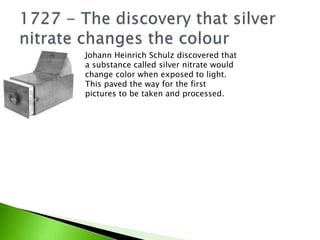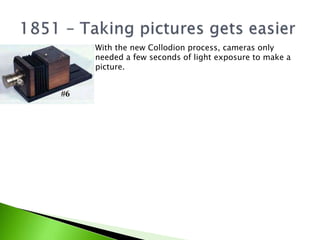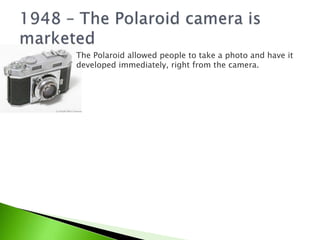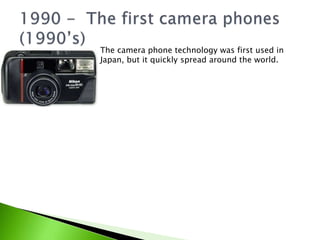Camera timeline – BTEC Home Learning
- 2. Johann Heinrich Schulz discovered that a substance called silver nitrate would change color when exposed to light. This paved the way for the first pictures to be taken and processed.
- 3. Joseph Niepce developed the camera obscura and took the first photo with it. It wasn't ideal, though, because it took 8 hours of light exposure to make a picture, and the picture faded with time.
- 4. Louis Daguerre invented a new way to take pictures. It only needed 30 minutes of light exposure, and the image didn't fade with time.
- 5. William Henry Talbot developed the Calotype process. This made it possible to make multiple copies of the same picture.
- 6. With the new Collodion process, cameras only needed a few seconds of light exposure to make a picture.
- 7. Up until this time pictures had to be developed immediately after being taken. Richard Leach Maddox invented the gelatin dry plate silver bromide process, which made it possible to take a picture and develop it later.
- 8. George Eastman invented the first roll-film camera.
- 9. The Polaroid allowed people to take a photo and have it developed immediately, right from the camera.
- 10. Polaroid came out with the first colored film.
- 11. Sony put out the first consumer camcorder, allowing people to record their memories in real time.
- 12. The Sasson Company built the first digital camera.
- 13. Canon put out the first digital camera for the public, which was later improved by Pixar.
- 14. The camera phone technology was first used in Japan, but it quickly spread around the world.
- 15. Kodak put out their Easy Share digital camera, which made it easy to snap pictures and download them to the computer.
- 16. Kodak put out cameras that didn't have to be connected to a computer in order to download and share the pictures.















